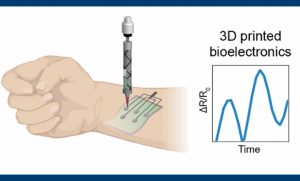Nanoink and 3D Printing Human Parts
November 8, 2022 | Terry Sharrer

Biomaterial inks can imitate human tissue characteristics
Biomedical engineers at Texas A&M University “have developed a class of shear-thinning hydrogels as biomaterial inks for 3D printing flexible bioelectronics. These hydrogels are engineered through a facile vacancy-driven gelation of MoS2 nanoassemblies with naturally derived polymer-thiolated gelatin. Due to shear-thinning properties, these nanoengineered hydrogels can be printed into complex shapes that can respond to mechanical deformation. The chemically cross-linked nanoengineered hydrogels demonstrate a 20-fold rise in compressive moduli and can withstand up to 80% strain without permanent deformation, meeting human anatomical flexibility.” MORE
AND
Image Credit: 3D Printing Media Network


